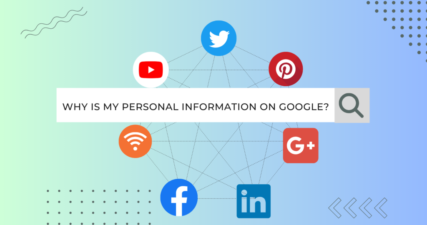How to Remove Personal Information From the Internet

In today’s digital age, protecting your personal information is crucial. Remove Personal Information From the Internet with these tips and strategies to safeguard your privacy.
The widespread availability of personal information on the internet can have serious consequences, including cyberstalking, identity theft, and even physical harm.
Moreover, with more people working and learning remotely, the potential for data breaches and other security incidents has increased dramatically. That’s why it’s more important than ever to take steps to protect your personal information and remove any sensitive data that may be available online.
Table of Contents
- Is it possible to remove personal information from the internet?
- TOP 10 things to do to rempersonal data online
- Remove your information from data brokers and people-search websites
- Close down unused or outdated online accounts
- Delete personal information from Google’s search results
- Manage privacy settings on your browsers and search engines
- Opt out of marketing associations and advertising tracking
- Restrict phone settings and permissions for your apps
- Secure your smart devices to protect your data
- Clean up or delete old email accounts
- Utilize new data privacy regulations to safeguard your information
- Enhance privacy measures for your social media profiles
- Final Thoughts
This article will guide you through the process of removing your personal information from the internet. We’ll explore various strategies, including conducting a personal information audit, contacting website owners to request removal, opting out of data brokers and people search engines, and taking proactive measures to protect your personal information going forward. By following these steps, you can take control of your online identity and safeguard your privacy.
Is it possible to remove personal information from the internet?
While it may seem overwhelming at first, removing your personal information from the internet is a crucial step in protecting your privacy and security. With the right approach and tools, you can take control of your personal data and minimize the risk of identity theft and other privacy violations. So if you’re ready to protect your personal information and keep your online identity secure, read on to learn how to remove personal information from the internet.
Before we delve into the top 10 things you can do to remove personal information from the internet, it’s worth noting that this process can be time-consuming and complex. If you’re short on time or would prefer to leave the task to professionals, consider working with a company that provides professional information removal services.
Our company offers expert guidance and support to help you remove personal information from the internet quickly and efficiently, so you can enjoy peace of mind and keep your online identity secure. With that said, let’s explore the top 10 things you can do to remove personal information from the internet.
TOP 10 things to do to rempersonal data online
Here are the top 10 things you can do to protect your personal information online and keep your data secure.
- Remove personal data from data brokers and people-search sites
- Close down any old or unused online accounts
- Increase privacy measures on social media accounts
- Remove your personal data from Google’s search results
- Manage your privacy settings on browsers and search engines
- Delete old or unnecessary email accounts
- Opt out of marketing associations and tracking
- Limit phone app permissions and settings
- Secure your smart devices to protect your personal data
- Take advantage of new data privacy laws to safeguard your information
Now that we’ve explored the top 10 things you can do to remove personal information from the internet and protect your data, let’s dive deeper into each section. In the following paragraphs, we’ll provide more detailed guidance on how to implement each of these strategies effectively.
Whether you’re a seasoned internet user or just getting started, these tips and strategies will help you take control of your online identity and safeguard your personal information. So let’s get started and learn how to remove personal information from the internet.
Remove your information from data brokers and people-search websites
Data brokers and people-search websites collect and sell personal information, including your name, address, phone number, personal documents, and email address. This information can be used for various purposes, including targeted advertising, identity theft, and fraud. To protect your privacy and prevent your personal information from being misused, it’s important to remove your information from these sites.
Here are some steps you can take to remove your information from data brokers and people-search websites:
Identify the data brokers and people-search websites that have your information
Use search engines to look up your name, address, phone number, and email address to see what information is available. This will help you identify the websites that have your information.
Opt out of data broker and people-search websites
Visit the opt-out page on each website and follow the instructions to have your information removed. This may require providing additional information, such as your name and email address, to verify your identity.
Submit a request to the website
If you cannot find an opt-out page, submit a request to the website to have your information removed. You may need to provide additional information, such as a copy of your ID, to verify your identity.
Monitor your information
Regularly monitor search engines and data broker websites to ensure that your information has been removed. If you find that your information is still available, contact the website to request removal.
Taking these measures can help you minimize the personal information that is publicly available online and safeguard your privacy from potential misuse.
Close down unused or outdated online accounts
Closing down unused or outdated online accounts is an important step in protecting your personal information. Leaving these accounts open can leave you vulnerable to data breaches, identity theft, and other forms of cybercrime. Here are some steps you can take to close down unused or outdated online accounts:
Identify the accounts
Make a list of all the online accounts you have created, including social media, online shopping, email, and other services.
Determine which accounts are no longer needed
Review each account to determine whether you still need them. If you haven’t used the account in a long time or if you no longer use the service, consider closing the account.
Follow the account closure process:
Each online service has its own process for closing an account. Look for a “Delete Account” or “Close Account” link in the account settings or help section of the service’s website. Follow the instructions to close the account.
Verify that the account is closed
After closing the account, make sure to verify that it has been closed. Try logging in to the account again to ensure that it is no longer accessible.
Closing down unused or outdated online accounts can help reduce your digital footprint and protect your personal information from being accessed by unauthorized parties. By regularly reviewing and closing these accounts, you can help safeguard your online privacy and security.
Delete personal information from Google’s search results

Google search is a powerful tool that can reveal a lot of information about you online. However, sometimes you may find that certain search results contain personal information that you would rather not be publicly available. Here are some steps you can take to delete personal information from Google’s search results:
Identify the search results
Search for your name on Google and review the search results. Look for any results that contain personal information, such as your address, phone number, or email address.
Determine if the information should be removed
Consider whether the information is outdated, inaccurate, or otherwise inappropriate to be publicly available. If so, you may be able to request that Google remove the search result.
Request removal
Visit Google’s Removals tool and submit a request to remove the search result. You will need to provide a valid reason for the removal request and may be required to provide additional information or documentation.
Monitor the results
After submitting a removal request, monitor the search results to ensure that the personal information has been removed. It may take several days for Google to process the request and remove the search result.
By deleting personal information from Google’s search results, you can help protect your privacy and reduce the amount of personal information that is publicly available online. However, it’s important to note that removing a search result does not delete the underlying information from the source website, so you may need to take additional steps to ensure that the personal information is fully removed from the internet.
Manage privacy settings on your browsers and search engines
Managing privacy settings on your browsers and search engines is an essential step to protect your personal information online. Here are some tips on how to manage privacy settings effectively:
Use privacy-focused browsers
Consider using a privacy-focused browser, such as Firefox or Brave, which offer built-in privacy features like ad-blocking, anti-tracking, and encrypted connections.
Clear browsing history and cookies
Regularly clear your browsing history and cookies to prevent websites from tracking your online activities.
Use private browsing mode
Use private browsing mode to prevent your browser from storing any history, cookies, or other data while you browse the internet.
Adjust search engine settings
Adjust the privacy settings on your preferred search engine to limit data collection and personalize search results.
Disable location tracking
Disable location tracking in your browser and search engine settings to prevent websites from accessing your physical location.
By taking these steps to manage your privacy settings, you can limit the amount of personal information that is collected and shared online and reduce your risk of identity theft or other privacy violations. It’s important to regularly review and update your privacy settings to ensure that you stay protected.
Opt out of marketing associations and advertising tracking
Opting out of marketing associations and advertising tracking is another crucial step to protect your personal information online. Here are some tips on how to do it effectively:
Use ad-blocking software
Consider using ad-blocking software, which can help prevent online ads from tracking your online activities.
Review privacy policies: Review the privacy policies of the websites you visit and the apps you use. Look for information on how they collect and use your data and whether they share it with third parties.
Opt out of data sharing
Many websites and apps offer the option to opt out of data sharing. Take advantage of this feature to limit the amount of personal data that is collected and shared.
Use a VPN
Consider using a Virtual Private Network (VPN) to encrypt your internet connection and prevent third parties from tracking your online activities.
Remove yourself from mailing lists
Remove yourself from mailing lists and unsubscribe from newsletters to limit the number of unwanted marketing messages you receive.
By taking these steps to opt out of marketing associations and advertising tracking, you can limit the amount of personal data that is collected and used for targeted advertising and reduce the number of unwanted marketing messages you receive. It’s important to regularly review and update your privacy settings and opt-out preferences to ensure that you stay protected.
Restrict phone settings and permissions for your apps
Restricting phone settings and permissions for your apps is another important step to protect your personal information. Here are some tips on how to do it effectively:
Review app permissions
Review the permissions that each app has on your phone. Consider revoking permissions that are not necessary for the app to function properly.
Be cautious when downloading apps
Only download apps from trusted sources such as the Google Play Store or Apple App Store. Read app reviews and research the developer before downloading.
Update your phone software
Keep your phone software up-to-date to ensure that you have the latest security patches and features.
Use two-factor authentication
Enable two-factor authentication for your important accounts to add an extra layer of security.
Use a passcode or biometric authentication
Set a passcode or use biometric authentication (such as fingerprint or facial recognition) to prevent unauthorized access to your phone and apps.
To minimize the chances of unauthorized access to your personal information, it’s important to restrict phone settings and app permissions. By taking this action, you can ensure that your data remains safe and secure. Regularly reviewing and updating your app permissions and security settings is also crucial to maintain the integrity of your personal information.
Secure your smart devices to protect your data
Securing your smart devices is essential to protect your personal information from being compromised. Smart devices such as phones, tablets, and smart home devices are connected to the internet and can be vulnerable to hacking attempts. To safeguard your data, it’s recommended that you enable security features such as passwords, PINs, or biometric authentication. Additionally, keeping your software up to date can also help prevent security vulnerabilities from being exploited.
In addition to enabling security features and keeping software up to date, there are several other measures you can take to secure your smart devices:
Use a virtual private network (VPN) to encrypt your internet connection and protect your online activity from prying eyes.
Disable unnecessary features or services that may collect or transmit personal information, such as location tracking or voice assistants.
Use two-factor authentication (2FA) for all your accounts to add an extra layer of security.
Regularly back up your data to a secure location to ensure you don’t lose any important information if your device is lost or stolen.
Install reputable antivirus software to scan for and remove any malicious software or viruses that may be present on your device.
You can significantly reduce the risk of your personal data being compromised and protect yourself from potential security breaches by implementing these additional measures to enhance the security of your smart devices.
Clean up or delete old email accounts
Cleaning up or deleting your old email accounts is an essential step in removing your personal information from the internet. Old email accounts may contain sensitive information, such as login credentials or personal correspondence, that could be exploited by cybercriminals if they fall into the wrong hands.
There are multiple reasons why it is crucial to clean up or delete old email accounts. First, old email accounts can contain a lot of personal information, such as your name, address, phone number, and even financial information. This information can be used by hackers or identity thieves to gain access to your other accounts or commit fraud. Second, old email accounts can also be vulnerable to security breaches if they are not regularly monitored or maintained.
To clean up or delete old email accounts, start by logging into each account and reviewing the contents. Look for any sensitive or personal information that you no longer need and delete it. You should also unsubscribe from any newsletters or promotional emails that you no longer want to receive. If you no longer use the email account, consider deleting it altogether.
When deleting an email account, make sure to check for any important emails or files that you may want to save. You may also want to update your contact information with any important contacts before deleting the account. Be aware that some email providers may have a waiting period before permanently deleting an account, so make sure to check their policies.
Overall, regularly cleaning up or deleting old email accounts can help protect your personal information and reduce the risk of security breaches.
Utilize new data privacy regulations to safeguard your information
As concerns about data privacy continue to grow, many countries and regions have enacted new data protection regulations to help safeguard individuals’ personal information. These regulations provide individuals with greater control over their data and place more responsibility on companies to ensure that their users’ data is collected, processed, and stored securely.
To take advantage of these regulations and better protect your personal information, it’s important to understand your rights under the law and how you can exercise them. This may include requesting access to your data, asking for it to be deleted, or opting out of certain data collection practices.
In this section, we’ll explore some of the key data privacy regulations and provide guidance on how you can utilize them to safeguard your information. It’s important to note that these regulations can vary by country and region, so it’s essential to research the specific laws that apply to your location.
Data privacy regulations are put in place to protect your personal information from being misused or mishandled. These regulations vary by country and region, but some of the most well-known regulations include the General Data Protection Regulation (GDPR) in the European Union, the California Consumer Privacy Act (CCPA) in the United States, and the Personal Information Protection and Electronic Documents Act (PIPEDA) in Canada.
To utilize these regulations to safeguard your information, you should first understand your rights under regulations. For example, under the GDPR, you have the right to access, correct, and delete your personal data, as well as the right to know how your data is being used and shared.
You can also take steps to exercise your rights under these regulations.
For example, you can submit a request to a company to delete your personal data or opt out of certain data collection practices.
It’s important to note that while these regulations can be helpful in protecting your personal information, they may not cover all situations or all types of data. Therefore, it’s important to also take other measures, such as those discussed in the previous sections, to fully safeguard your information.
Enhance privacy measures for your social media profiles

Enhancing privacy measures for your social media profiles is a crucial step in protecting your personal information online. Social media platforms collect a wealth of data on their users, including demographic information, browsing history, and even location data. This information can be used to target users with ads and even sold to third-party advertisers. To ensure that your social media profiles are as secure as possible, it’s important to take the following steps:
Review your privacy settings
Social media platforms offer a variety of privacy settings that allow you to control who can see your posts, profile information, and other data. Take the time to review these settings and adjust them as necessary to ensure that only people you trust can access your information.
Be mindful of what you post
Even if you have strict privacy settings in place, it’s important to be careful about what you post on social media. Avoid sharing personal information such as your home address or phone number, and think twice before posting photos or other content that could be used to identify you.
Use 2FA
Two-factor authentication adds an additional layer of security to your social media accounts by requiring a code in addition to your password to log in. This can help prevent unauthorized access to your accounts even if your password is compromised.
Limit app permissions
Many social media apps request access to a variety of permissions on your phone, such as your contacts or location data. Be sure to review these permissions carefully and only grant access when it’s absolutely necessary.
By following these measures, you can safeguard your personal information on social media and decrease the likelihood of unauthorized access.
Final Thoughts
In the current era of technology and the internet, protecting your personal information online is more important than ever before. From data brokers and people-search sites to social media platforms and search engines, there are many ways that your personal information can be collected and used without your knowledge or consent. However, by following the steps outlined above, you can take control of your online privacy and reduce the risk of your personal information being compromised.
It’s also important to remember that if you’re struggling to remove your personal information from the internet or need additional assistance with securing your online privacy, professional services are available.


